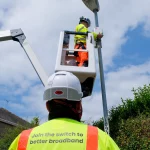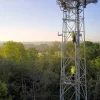BT Moot UK Airborne Drones to Help Broadband Cover or Telecom Repairs
BT says that in the future their Internet and phone related UK engineering tasks could be improved, especially in remote rural areas, by harnessing semi-autonomous flying drones to “deliver urgent parts for our network” or provide “temporary broadband access” (please don’t call it Fibre-to-the-Drone).
According to BT’s Head of Customer Innovation, Global Banking and Financial Markets, Matthew Key, “drones are set to play an increasingly important role in all our lives” and technological innovations, such as better / lighter batteries or GPS tracking, may soon make them viable tools for use by BT’s own engineering teams.
Advertisement
Matthew Key said:
“We could use drones to deliver urgent parts for our network. This would be especially useful for rural, hard-to-reach areas across the UK. It would be a much faster way to get things to where they need to be and improve the customer experience.
If your network is damaged by a flood, or another natural disaster, drones could fly over and assess what needs to be done — and we could get you back online as quickly as possible.
They could even give you temporary broadband access if there’s a disruption to the network. Or broadcast broadband at big events like music festivals. And they could transmit mobile signals too, if needed. In the future, we could also help customers tackle logistical, agricultural and energy challenges with their drone deployments.
Drones are such a new technology that we probably haven’t even begun to scratch the surface of what they can do. Computers were created to solve maths problems, now we use them to connect people across the globe. With a little creativity, drones could change the world.”
At present most of those out there who have some experience of drones will probably be familiar with the buzzing sound they make (akin to a swarm of angry bees after they’ve been forced to watch a single episode of Eastenders), which is usually followed approximately 5-8 minutes later by a loud crack as said device crashes back to earth due to a misjudgment of battery life by the operator.
Various organisations, such as Amazon, the military or even the NHS, also see them as potentially useful tools for performing tasks like package delivery or scouting enemy territory. Mind you, BT’s idea of using drones for temporary broadband coverage is likely to be a long way off because battery life and equipment weight remain a significant hindrance (it might be cheaper to use a small helium balloon and station it above the area).
However Matthew Key notes that the “highest hurdle” in all this is still regulation. For example, the current rules stipulate that drones in the UK must remain within sight of the operator, so he or she can be seen to have control. This makes sense given the obvious threat from terrorism or antisocial abuse, yet such restrictions also stifle innovation.
But Key states that as the industry matures then “these rules are expected to be relaxed and drones will be allowed to reach their full potential“, which could open the door for some of BT’s grander ambitions. The above comment was posted on the operator’s technology blog yesterday, although curiously BT has since chosen to remove it; luckily we saw it before they took the content offline 😉 .
Advertisement
Mark is a professional technology writer, IT consultant and computer engineer from Dorset (England), he also founded ISPreview in 1999 and enjoys analysing the latest telecoms and broadband developments. Find me on X (Twitter), Mastodon, Facebook, BlueSky, Threads.net and Linkedin.
« UK ISP Sky Broadband Unlimited Price Rises to GBP10 Per Month
















































Comments are closed